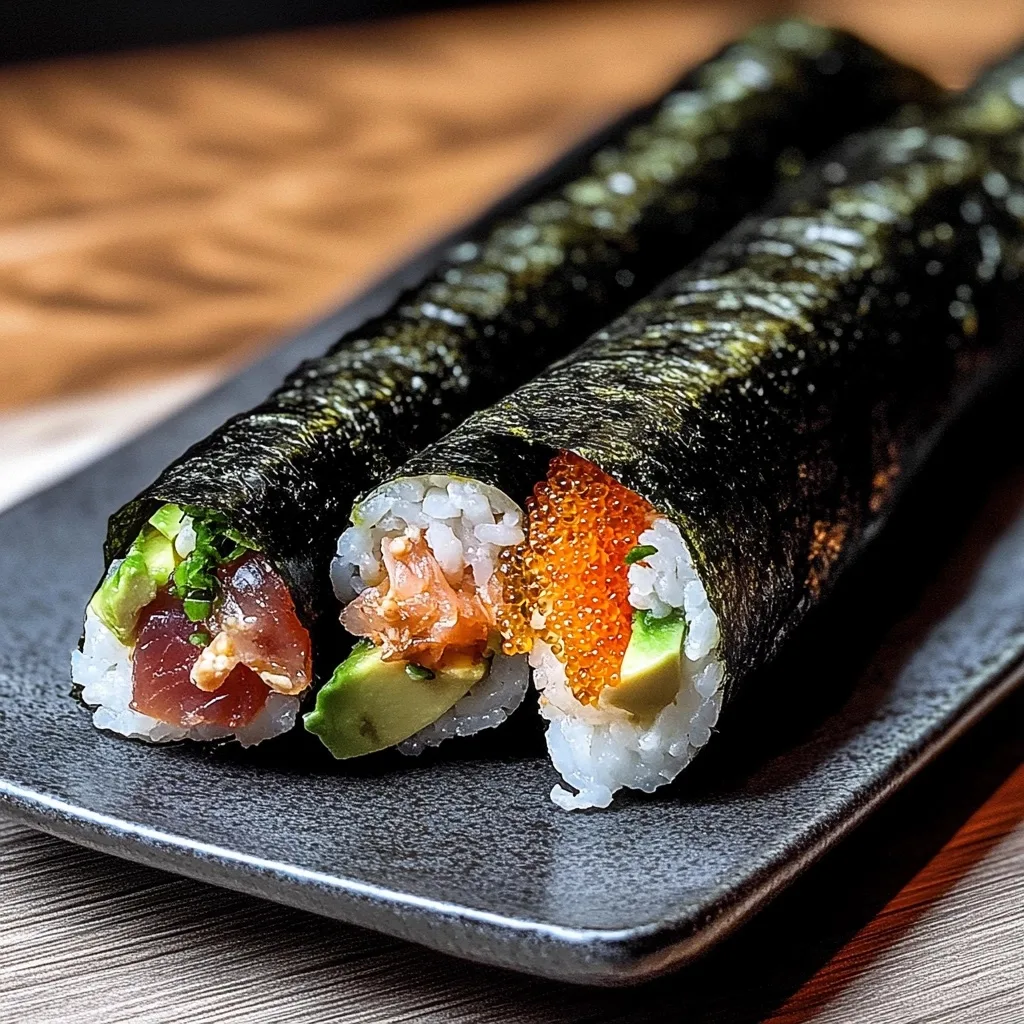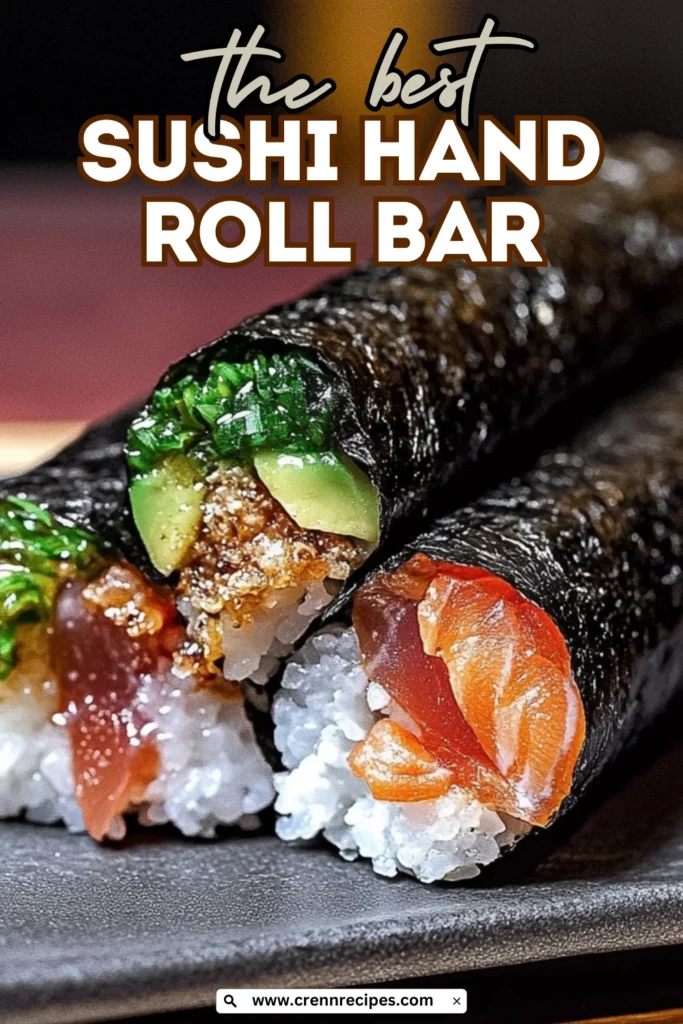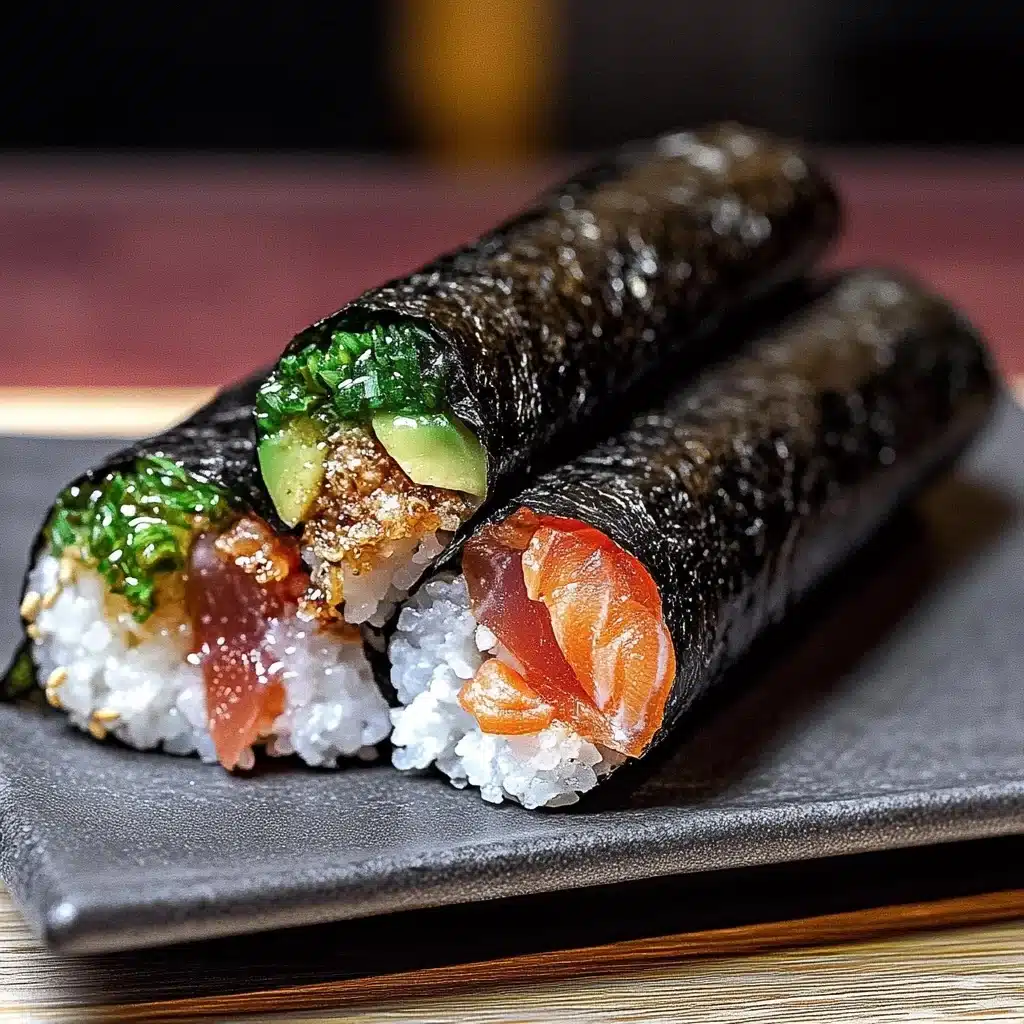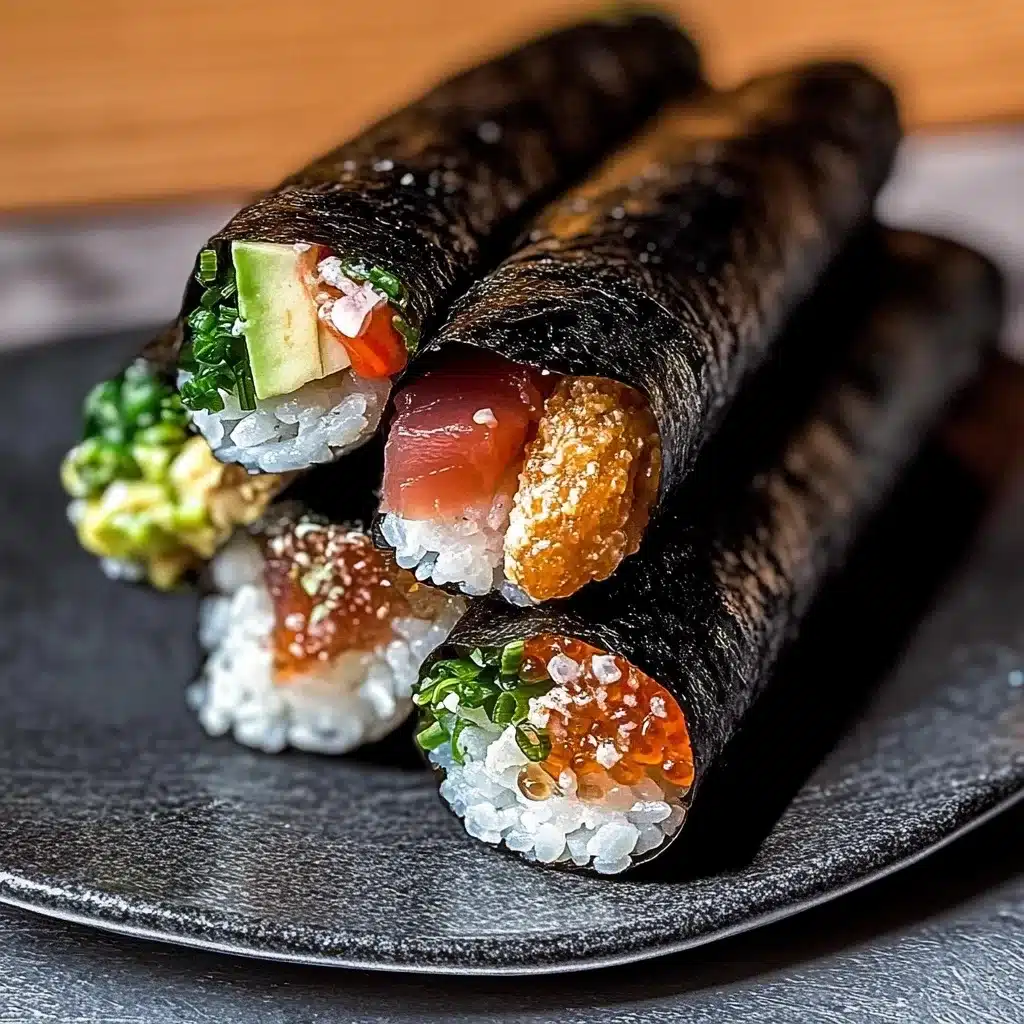There’s something undeniably magical about gathering around a table filled with colorful ingredients, each person crafting their own perfect bite. A Sushi Hand Roll Bar (also known as Temaki sushi) transforms dinner into an interactive experience that delights both the eyes and the palate. This Japanese-inspired feast allows everyone to customize their own hand-rolled creations, making it ideal for families with varying tastes, dinner parties where conversation flows naturally during assembly, or a fun date night activity that’s sure to impress.
Unlike traditional maki rolls that require bamboo mats and precise rolling techniques, hand rolls are beginner-friendly and forgiving. The cone-shaped temaki rolls showcase vibrant ingredients while being substantially easier to prepare than their restaurant counterparts. Best of all, the preparation is front-loaded – once your ingredients are prepped and arranged, you can relax and enjoy the meal alongside your guests.
In this comprehensive guide, you’ll discover everything you need to know about hosting a memorable Sushi Hand Roll Bar at home: from selecting the freshest ingredients and preparing the perfect sushi rice to arranging an Instagram-worthy spread and mastering the hand roll technique. Let’s dive into this culinary adventure that’s as much about the experience as it is about the delicious flavors.
The Art and History of Temaki Sushi
Temaki sushi, which translates to “hand roll sushi,” has deep roots in Japanese culinary tradition but has evolved into a social dining experience that perfectly fits our modern desire for customization and interactive meals. While traditional sushi has been prepared by trained itamae (sushi chefs) for centuries, temaki represents the more casual, homestyle approach to enjoying these flavors.
Unlike the precisely formed nigiri or maki rolls you might find at high-end sushi restaurants, temaki began as a practical solution for home cooks. The cone-shaped hand rolls allowed families to enjoy sushi’s delicious combinations without requiring specialized equipment or years of training. What started as convenience has transformed into a celebrated style of its own, valued for both simplicity and the social dining experience it creates.
The beauty of temaki lies in its adaptability. While respecting traditional Japanese flavor profiles, the hand roll format welcomes creativity and fusion. This accessibility has helped sushi transcend cultural boundaries to become a global favorite, with temaki parties growing increasingly popular for casual entertaining across America, Europe, and beyond.
Nutritionally, a sushi hand roll bar offers impressive benefits. The fish provides high-quality protein and omega-3 fatty acids, while vegetables contribute essential vitamins, minerals, and fiber. Nori seaweed contains significant amounts of iodine, vitamin B12, and antioxidants. When prepared with attention to ingredient quality and portion sizes, this meal becomes not just a delicious treat but a balanced, nutrient-dense dining option.

Essential Ingredients for Your Sushi Hand Roll Bar
The Foundation: Rice and Nori
At the heart of any successful sushi hand roll is properly prepared sushi rice. This isn’t just regular steamed rice – it’s short-grain Japanese rice seasoned with a vinegar mixture that creates the distinctive flavor and texture that makes sushi, well, sushi. The rice should be sticky enough to hold together but still maintain distinct grains with a subtle sheen.
For authentic results, look specifically for short-grain Japanese rice labeled as “sushi rice” or “Calrose rice.” The cooking process requires careful attention to the rice-to-water ratio (typically 1:1.1) and proper resting time after cooking. Once cooked, the rice is seasoned with a mixture of rice vinegar, sugar, and salt that’s been heated just enough to dissolve the solids. This seasoning mixture, called sushi-zu, gives the rice its characteristic tangy flavor that balances the other ingredients.
Equally important are the nori sheets – the paper-thin dried seaweed that serves as the wrapper for your hand rolls. Quality matters here; premium nori has a deep green-black color, delicate texture, and subtle oceanic flavor without excessive fishiness. For hand rolls, full-sized nori sheets should be cut in half to create the perfect size for forming cones. Store nori in an airtight container until ready to use, as it quickly absorbs moisture from the air and loses its desirable crisp texture.
Protein Options: From Traditional to Creative
The protein component of your hand rolls offers endless opportunities for variety. Traditional options include sushi-grade raw fish such as salmon, tuna, and yellowtail. When serving raw fish, quality is non-negotiable – purchase from reputable fishmongers or Japanese markets that specifically sell sushi-grade fish, which has been properly handled and frozen to eliminate parasites.
For those who prefer cooked options, consider imitation crab sticks (surimi), cooked shrimp, or even teriyaki chicken for a fusion approach. Vegetarians can enjoy hand rolls with tofu, either marinated or fried, as a protein alternative.
One particularly popular preparation is spicy tuna – chopped raw tuna mixed with sriracha, mayonnaise, and sometimes a touch of sesame oil. This mixture adds a creamy heat that many find irresistible. Similarly, salmon can be prepared with a spicy treatment or mixed with finely chopped scallions for added dimension.
When serving a diverse group, offering both raw and cooked protein options ensures everyone can participate regardless of dietary preferences or comfort levels with raw seafood.
Fresh Vegetables and Extras That Make the Difference
The vegetable components add crucial textural contrast, color, and nutritional value to your hand rolls. Cucumber provides refreshing crunch when cut into thin julienne strips (remove the seedy center for best results). Avocado contributes creamy richness and is best prepared just before serving to prevent browning. Carrots offer vibrant color and sweet crunch, especially when cut into thin matchsticks.
Beyond these basics, consider including green onions (scallions) for sharp flavor, sprouts for delicate texture, thinly sliced radish for peppery bite, or pickled vegetables for tangy contrast. Japanese pickled ginger (gari) serves as both a palate cleanser between different roll combinations and an optional filling.
For added texture and flavor complexity, incorporate elements like tobiko (flying fish roe), tempura flakes (tenkasu), or toasted sesame seeds. A surprise favorite at many hand roll bars is cream cheese, which, while not traditional, pairs remarkably well with salmon in particular.
Each additional offering increases the possible combinations, allowing guests to discover their personal perfect roll. The key is balance – providing enough variety without overwhelming your guests or your preparation capacity.
Sauces and Condiments That Elevate the Experience
The finishing touches for your sushi hand roll bar come in the form of sauces and condiments that can transform simple ingredients into complex flavor experiences. Traditional offerings include:
- Soy sauce – Preferably Japanese shoyu, which offers more complexity than Chinese-style soy sauce. Consider offering both regular and low-sodium options.
- Wasabi – The green horseradish paste that provides sinus-clearing heat. Authentic wasabi is difficult to find outside Japan; most “wasabi” is actually horseradish with food coloring, but it still provides the expected flavor experience.
- Pickled ginger – Beyond its role as a palate cleanser, this can be incorporated into rolls for tangy sweetness.
For those who enjoy spicy food, sriracha mayo combines the creamy richness of mayonnaise with chile heat. Make it by simply mixing mayonnaise with sriracha to taste, or add a drop of sesame oil for depth. Eel sauce (unagi sauce) offers sweet-savory notes and can be purchased premade or prepared by reducing soy sauce, mirin, and sugar.
For an extra special touch, prepare a simple ponzu sauce by combining soy sauce with fresh citrus juice (typically yuzu, but lemon or lime work well). This bright, acidic condiment cuts through richer ingredients and adds extraordinary dimension to simple rolls.
Setting Up Your Sushi Hand Roll Bar
Preparation Timeline and Organization
The key to hosting a stress-free sushi hand roll bar lies in thoughtful preparation and organization. Here’s a timeline to help you plan:
1-2 days before:
- Shop for non-perishable items (nori, rice, vinegar, soy sauce)
- Clean and organize serving bowls and platters
- Prepare any sauces that will keep well (like spicy mayo)
Morning of your event:
- Purchase fresh seafood and vegetables
- Wash and prep any vegetables that won’t discolor (carrots, cucumbers)
- Cook and season the sushi rice (it can be held at room temperature for several hours)
1 hour before guests arrive:
- Slice proteins and arrange on chilled platters
- Prepare avocado and any other items that oxidize quickly
- Arrange your serving station with all necessary components
- Cut nori sheets in half and store in an airtight container
Organization is crucial not just for timing but for the physical layout of your hand roll bar. Arrange ingredients in a logical sequence that mirrors the assembly process: nori sheets first, followed by rice, proteins, vegetables, and finally condiments. This creates a natural flow that makes assembly intuitive even for first-timers.
Consider using a lazy Susan for condiments so they’re easily accessible to everyone at the table. Label ingredients for guests who might be unfamiliar with certain components, perhaps including suggested combinations for those who might feel overwhelmed by too many choices.
Creating an Inviting Display
The visual appeal of your sushi hand roll bar contributes significantly to the experience. Consider these presentation tips:
- Use a variety of serving vessels in complementary colors or materials – ceramic bowls, wooden platters, and slate boards create textural interest
- Arrange ingredients by color for maximum visual impact, alternating between bright and neutral tones
- Elevate some items using cake stands or inverted bowls under platters to create height variation
- Include small decorative elements like scattered sesame seeds, microgreens, or edible flowers
- Incorporate Japanese-inspired serving pieces like bamboo mats, wooden sushi geta boards, or ceramic sauce dishes
Lighting matters too – soft, warm lighting elevates the dining experience while still providing enough illumination for guests to see what they’re assembling. Consider tea lights in small holders scattered between serving dishes for a magical effect.
Don’t neglect the practical elements: provide small bowls for soy sauce, designated spoons or tongs for each ingredient, plenty of napkins, and perhaps moist towelettes for sticky fingers. These thoughtful touches show attention to detail that guests will appreciate.
Mastering the Hand Roll Technique
While hand rolls are more forgiving than traditional maki rolls, there’s still a technique that ensures success. Consider printing simple visual instructions or demonstrating the process for first-time guests:
- Hold a half sheet of nori in your non-dominant hand, shiny side down
- Place a small amount of rice (about 2 tablespoons) diagonally across the left corner of the nori, leaving the bottom right corner empty
- Add fillings in a line on top of the rice – less is more when it comes to fillings
- Fold the bottom left corner of the nori over the fillings, then continue rolling into a cone shape
- The moisture from the rice will help seal the roll closed
- Eat immediately while the nori is still crisp
The key technique points to emphasize are using restraint with the fillings (overstuffing leads to structural failure), keeping the rice to one area rather than spreading it all over the nori, and eating promptly after assembly before the nori softens.
For beginners, starting with simpler combinations allows them to focus on technique before exploring more complex flavor profiles. Consider suggesting starter combinations like salmon, avocado and cucumber or imitation crab with avocado and tempura flakes.

Hosting Tips for a Memorable Sushi Hand Roll Experience
Creating Interactive Dining Fun
The interactive nature of a sushi hand roll bar creates natural conversation and shared experience. Enhance this aspect by encouraging creativity and providing some structure:
- Create name cards for suggested combinations based on your guests’ preferences
- Host a friendly competition for the most creative or beautiful hand roll
- Provide small notecards for guests to write down successful combinations they discover
- Take polaroid photos of particularly impressive creations for a visual memory of the evening
Consider timing your event to allow for a leisurely pace. Unlike plated dinners with courses, the sushi hand roll bar encourages grazing and experimentation over time. Plan for the experience to last 1.5-2 hours, with fresh ingredients replenished as needed.
For larger gatherings, set up multiple stations to avoid bottlenecks. Each can feature slightly different ingredients, encouraging guests to move around the room and interact with different people as they try new combinations.
Beverage Pairings That Complement
The right beverages enhance the sushi experience. Traditional Japanese options include:
- Green tea – The classic accompaniment, particularly hojicha (roasted green tea) whose toasty notes complement the oceanic flavors
- Sake – Available in a range of styles from dry to sweet; consider offering a tasting flight
- Japanese beer – Light lagers like Sapporo, Asahi, or Kirin provide refreshing contrast
For wine lovers, opt for high-acid, mineral-driven whites like Chablis, Sancerre, or Albariño that won’t overpower delicate fish flavors. Sparkling options like Champagne or Prosecco also pair beautifully.
Non-alcoholic options might include cucumber-infused water, yuzu lemonade, or sparkling water with a splash of unsweetened cranberry juice. The key is selecting beverages that refresh the palate without overwhelming the subtle flavors of the hand rolls.
Accommodating Dietary Restrictions and Preferences
A sushi hand roll bar naturally lends itself to accommodating various dietary needs. Consider these adaptations:
- Vegetarian/Vegan: Beyond vegetables, offer tofu, seaweed salad, or plant-based “tuna” made from tomatoes as protein alternatives
- Gluten-Free: Provide tamari instead of regular soy sauce; ensure any pre-made sauces are gluten-free
- Raw Fish Concerns: Always include cooked protein options like teriyaki chicken, tempura shrimp, or cooked crab
- Low-Carb: Offer lettuce cups as an alternative to nori for those avoiding grains
Clearly label ingredients and potential allergens. For guests with severe allergies, consider separate serving utensils and designated areas of the table to prevent cross-contamination.
Recipe Variations and Creative Extensions
Fusion Flavors That Work Surprisingly Well
While traditional Japanese flavors form the foundation of hand rolls, fusion elements can create exciting new combinations:
- Korean-Inspired: Add kimchi and bulgogi (Korean marinated beef) for a spicy-sweet variation
- Mexican Fusion: Incorporate mango, jalapeño, and cilantro for a tropical-spicy twist
- Mediterranean Twist: Try combining tuna with olive tapenade and sundried tomatoes
These cross-cultural adaptations honor the hand roll format while introducing unexpected flavor profiles. The key is maintaining balance – one bold flavor per roll, complemented by more subtle components.
For a breakfast-inspired brunch option, consider smoked salmon with cream cheese, capers, and thinly sliced red onion – reminiscent of a bagel with lox but in hand roll form.
Kid-Friendly Approaches
A sushi hand roll bar can be wonderfully child-friendly with some thoughtful adaptations:
- Set up a dedicated “kids’ station” at a lower height with simplified ingredients
- Offer familiar proteins like teriyaki chicken, cooked shrimp, or even ham
- Include mild, sweet vegetables like corn kernels or sweet bell peppers
- Make “training chopsticks” available or provide fun children’s chopsticks
- Create pre-filled nori cones for very young children who might struggle with assembly
Turn the experience into an educational opportunity by talking about different fish, ocean conservation, or Japanese culture while creating rolls together. Many children who might resist trying new foods are more willing when they’ve participated in preparation.
Dessert Hand Rolls: A Sweet Finish
Extend the hand roll concept into dessert for a playful end to your meal:
- Use thin crepes instead of nori as wrappers
- Fill with sweetened cream cheese or mascarpone as the “rice” element
- Add fresh berries, sliced bananas, or other fruits
- Incorporate chocolate shavings, crushed cookies, or toasted nuts
- Drizzle with chocolate sauce, caramel, or honey as “soy sauce”
This unexpected dessert application maintains the interactive, customizable nature of the hand roll bar while transitioning to sweet flavors. It’s especially popular with children and provides a memorable finish to the meal.

Troubleshooting Common Sushi Hand Roll Challenges
Rice Perfection Problems and Solutions
The rice is often the most technically challenging component of sushi. Here’s how to address common issues:
- Too sticky/gummy: You’ve likely used too much water or overcooked the rice. Next time, reduce the water slightly and be careful not to overstir when adding the vinegar mixture.
- Too firm/separate: Increase water slightly or allow longer steaming time after cooking. Make sure you’re using short-grain sushi rice, not medium or long-grain varieties.
- Vinegar flavor too strong: The seasoning should be subtle. Reduce the amount of vinegar mixture or increase the sugar slightly to balance acidity.
- Rice sticking to hands: Keep a small bowl of water with a splash of rice vinegar nearby to moisten hands before handling rice.
Remember that properly made sushi rice should be served at body temperature or slightly cooler – not hot from the cooker nor refrigerated.
Fresh Fish Safety Considerations
When serving raw fish, safety is paramount:
- Always purchase from reputable sources that specifically sell sushi-grade fish
- Transport fish in a cooler with ice packs and refrigerate immediately
- Prepare fish just before serving and keep chilled until needed
- Use separate cutting boards and knives for raw fish preparation
- If you’re uncertain about sourcing truly sushi-grade fish, opt for cooked seafood alternatives
“Sushi-grade” generally means the fish has been frozen at temperatures low enough to kill potential parasites according to FDA guidelines. This is not something to compromise on, regardless of how fresh the fish appears.
For pregnant women, young children, elderly individuals, or those with compromised immune systems, always offer fully cooked options to eliminate any risk associated with raw consumption.
Storage and Leftovers Management
With proper planning, you can minimize leftovers, but some may be inevitable:
- Cooked proteins can be refrigerated and used in salads or rice bowls the next day
- Fresh vegetables will keep for several days if stored properly
- Prepared sushi rice doesn’t store well and is best used within a few hours
- Leftover nori quickly absorbs moisture and loses its crisp texture – store with desiccant packets in an airtight container but expect quality degradation
Consider setting out smaller amounts of perishable items and replenishing as needed rather than putting everything out at once. Provide takeout containers for guests to create one last roll to enjoy later if there are substantial leftovers.
Frequently Asked Questions
Can I prepare sushi rice in advance?
Sushi rice is best prepared 1-3 hours before serving. Once seasoned, cover with a damp towel (not plastic wrap) and keep at room temperature. Don’t refrigerate, as cold temperatures harden the rice and damage its texture. If you must make it further ahead, let it come to room temperature for at least 30 minutes before serving.
What’s the difference between sushi-grade fish and regular fish?
“Sushi-grade” fish has been handled according to specific protocols to minimize parasite risk, including flash-freezing at temperatures lower than standard freezers can achieve. Regular fish from grocery stores hasn’t undergone these processes and isn’t safe to consume raw. Only purchase fish for raw consumption from reputable fishmongers who specifically designate fish as sushi-grade.
How can I make this more budget-friendly?
A sushi hand roll bar can be adapted to any budget:
- Focus on vegetable fillings with just one premium protein option
- Use canned tuna mixed with mayo and sriracha instead of fresh tuna
- Incorporate cooked proteins like teriyaki chicken which are less expensive than sushi-grade fish
- Make it a potluck where guests each bring one component
- Scale down the variety of options while maintaining quality of core ingredients
What if my guests don’t know how to make hand rolls?
Most people catch on quickly, but you can:
- Create a simple illustrated instruction card at each place setting
- Demonstrate the technique as guests arrive
- Pre-roll a few examples for visual reference
- Offer to make the first round for those who seem hesitant
Remember that imperfection is part of the charm of a hand roll bar – awkward first attempts lead to laughter and shared experience that enhances the social aspect of the meal.
The Joy of Sushi Hand Roll Gatherings
A sushi hand roll bar represents more than just a meal – it’s an experience that brings people together through shared creation and discovery. In our busy world of convenience foods and rushed dining, taking the time to assemble each bite mindfully offers a refreshing return to the joy of eating with intention.
The beauty of this concept lies in its flexibility. It can be as simple or elaborate as suits your occasion, budget, and comfort level. From an intimate date night to a festive gathering of friends, the interactive nature of hand rolls creates natural conversation and connection.
We encourage you to make this concept your own. Start with the guidelines provided here, then adapt based on your preferences and those of your guests. Document successful combinations, note which ingredients were most popular, and refine your offerings with each hosting experience. A sushi hand roll bar can become your signature entertaining style – one that guests will look forward to and remember long after the last bite is enjoyed.
More Related Recipes You Might Enjoy
- Crunchy Buffalo Chicken Bacon Ranch Wraps – Another handheld, customizable meal perfect for casual entertaining
- Haunted Oreo Graveyard Cake – A fun, interactive dessert option that’s perfect for themed gatherings
- Summer Berry Meal Prep – Fresh, vibrant ingredients prepped ahead for easy meals, similar to the approach for a sushi hand roll bar

Sushi Hand Roll Bar: 7 Secrets for an Amazing DIY Experience
- Total Time: 20 minutes
- Yield: 3 hand rolls
Description
These elegant hand-rolled sushi cones showcase three classic temaki combinations featuring sushi-grade tuna, fresh salmon, creamy avocado, and vibrant orange tobiko (flying fish roe). The crisp nori wraps hold perfectly seasoned sushi rice and colorful fillings in an easy-to-eat cone shape.
Ingredients
- Nori sheets (seaweed)
- Sushi rice
- Sushi-grade tuna
- Fresh salmon
- Avocado
- Tobiko (flying fish roe)
- Cucumber
- Green onions
- Soy sauce for dipping
Instructions
- Hold a half sheet of nori with the shiny side down
- Place 2 tablespoons of sushi rice diagonally on one corner
- Add your choice of fillings on top of the rice
- Fold the nori into a cone shape, using the rice to help seal the edge
- Serve immediately with soy sauce for dipping
Notes
Hand rolls should be eaten immediately after preparation to enjoy the crisp nori texture. For best results, use high-quality nori sheets and properly seasoned sushi rice.
- Prep Time: 20 minutes
- Cook Time: 0 minutes (assembly only)
- Category: Appetizer
- Method: Hand-rolling
- Cuisine: Japanese
Nutrition
- Serving Size: 1 hand roll
- Calories: 185
- Sugar: 1g
- Sodium: 320mg
- Fat: 6g
- Saturated Fat: 1g
- Unsaturated Fat: 5g
- Trans Fat: 0g
- Carbohydrates: 22g
- Fiber: 2g
- Protein: 10g
- Cholesterol: 25mg

